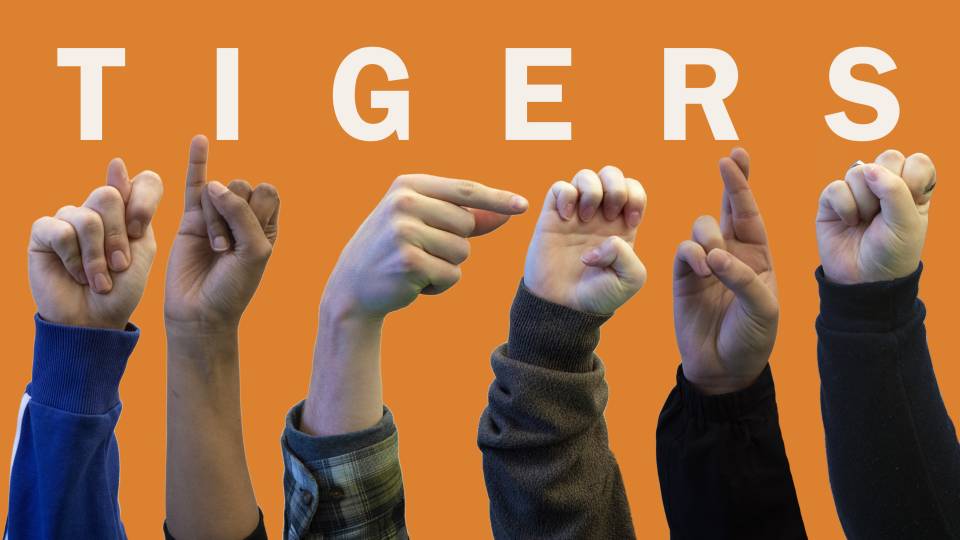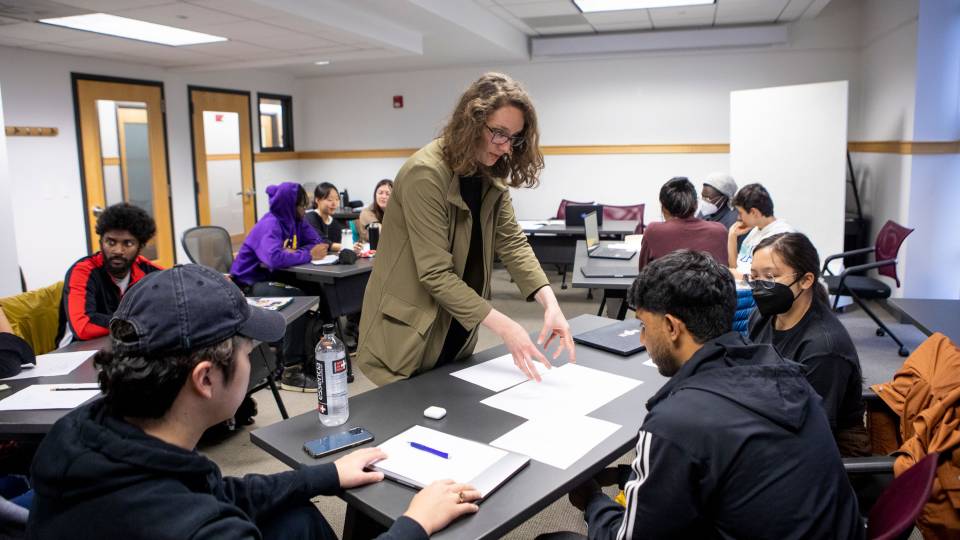Representatives of the New Jersey Commission for the Blind and Visually Impaired demonstrate special screen readers for people with visual impairments at the workshop “Introduction to Accessibility,” one of six courses offered to Princeton University employees through the User Experience Office.
Before Princeton University’s Pace Center for Civic Engagement revamped its website this past year, the center’s Communications Coordinator Gwen McNamara wanted to know more about who was visiting the site and how to make it a better resource for the entire campus.
To find out, McNamara took a decidedly low-tech approach: She and a student volunteer set up a table at Frist Campus Center with a tray of cupcakes to entice students to answer questions about the Pace Center and also about service at Princeton, more generally. “We established a goal that we really wanted to understand the Princeton student service experience to inform how we could leverage our website as an effective tool,” she said.

A handheld reading device alternates text and background colors to make text more legible for those who have difficulty reading black type on a white background. By learning about the needs and preferences of different users, University employees who design web, mobile and other software applications can make technology more accessible for all.
The insights gleaned from the survey mirrored what McNamara was seeing in the site’s analytics — that students were landing on the Pace Center’s website for single-page visits, then leaving almost as quickly as they arrived. But finally, she understood why: When students have questions about service, they usually ask their friends instead of searching online.
This type of comprehensive user research for web and software development has become more common across the University since Princeton’s User Experience Office was established in early 2016. As part of the Office of Information Technology, the User Experience Office offers guidance, methods and tools, and training and certifications for all University employees who purchase, maintain or develop technology.
Princeton maintains close to 1,000 websites across 91 academic departments and interdepartmental organizations, as well as dozens of administrative departments. While many sites have been updated and brought up to standards, many others need improvement.
There also are numerous in-house software applications in use, as well as applications from outside vendors, such as Blackboard, which some professors use to administer courses.
“The value of user experience design in IT is that, at its best, it helps people who must use a technology to accomplish their tasks in ways that are most effective and meaningful to them,” said Mary Albert, associate director of the User Experience Office. “As a discipline, it is based on principles in cognitive psychology and product design, and it recognizes that the interaction between a person and a tool should be optimized for the person. As a practice, it provides a toolkit of techniques that takes the guesswork out of designing effective interfaces.”
It accomplishes that by beginning with end users of technology and researching their needs. From that research, a model is created that can be tested early in the product cycle.
“It gives customers an opportunity to test the model, and through iterative design and testing, say ‘yes,’ — to confirm that it meets their expectations and capabilities,” Albert said. “Just as importantly, it supports project success and efficiency since everyone on the team can use the results of the test to make improvements and changes before development or before a purchase decision is made.”
Albert added: “Technology has become essential to daily work and study, which means the need for all kinds of people to access information and quickly, and to complete tasks more easily, never has been more critical. A prospective student seeking admissions information, a faculty member conducting research or sharing a course syllabus, or a department manager forecasting a budget, all require technology to accomplish their goals.”
While Albert said it is difficult to estimate the number of Princeton employees responsible for purchasing and maintaining technology, one thing is clear: The demand for consultation and training to make all types of technology live up to its promise of utility and ease never has been higher.
“One of the motivations for starting up the User Experience Office is that our colleagues around campus have become much more sophisticated users of IT,” Albert said. “That sophistication is part of the consumerization of IT. People demand higher levels of attractiveness, perfection and ease of use than they did in the past.”

Josh Cartagena, web and technical services specialist for Princeton’s School of Engineering and Applied Science, explains to a group of Princeton employees the changes he made to the engineering school’s website based on user research and testing.
Building a user-first mindset
Employees from all parts of the University — among them representatives from the Princeton University Library, Facilities, the Office of Information Technology and the Office of Communications — have attended courses the User Experience Office offers.
As of September, 288 University employees had completed one of the UX Office’s six basic courses on user experience design. The courses cover all the major components of user experience from how to conduct user research to writing for the web to designing and testing prototypes to IT accessibility.
Forty-six employees have completed the full cycle of classes to earn a Fundamentals of User Experience certificate. Others have gone further, gaining professional credentials in accessibility, which addresses accommodations for individuals with impaired vision, hearing, mobility and cognitive function.
To date, 59 University employees have passed the Certified Professional in Accessibility Core Competencies (CPACC) exam for an accessibility certification offered in conjunction with the International Association of Accessibility Professionals. In fact, Princeton has more CPACC-credentialed employees than any other organization in the world, said Damian Sian, senior adviser for web accessibility in the User Experience Office.
This fall, an additional 35 employees have signed up for CPACC training, which entails more than 60 hours of class time and study sessions, plus a two-hour exam. To maintain the certification, employees must complete 15 hours of continuing education each year. “I’ve been training on the topic of disability for years, and I’ve never had that kind of commitment from people,” Sian said. “We thought that because it is so much work we were going to get 10 or 15 people at most. Instead, that many go on the wait list each time we train a cohort.”
Those who have gone through user experience or accessibility training now form a network of like-minded professionals seeking solutions to common usability problems. The User Experience Office moderates group chats through its own Slack channel and maintains a listserv. It also hosts bi-monthly “Design and Dessert” sessions for employees to share new techniques and to help each other troubleshoot issues, as well as accessibility meetups that are open to the University community and the public.
“I’m so glad that they’re here because in a lot of ways this is very new to Princeton,” said Josh Cartagena, web and technical services specialist for Princeton’s School of Engineering and Applied Science, about the User Experience Office. “Having them as a resource is great for conversations.”
Cartagena, who has earned the Fundamentals of User Experience certificate and CPACC, already has made several adjustments to the engineering school’s website based on what he learned.

Susan Spraragen, senior user experience researcher, leads a discussion at the User Experience Office’s monthly “Design and Dessert” meet-up. All employees who want to share best practices and network with like-minded peers are welcome to attend.
Most recently, he hosted a usability testing session with six engineering graduate students at Small World Coffee, bringing laptops for the students to test web designs. “It was really great, really candid,” Cartagena said. “We learned a lot of insights on how they expect to use the site versus what we actually provide.”
Based on his observations and discussions with the students, Cartagena proposed new homepage features that will help prospective engineering graduate students find information they need more easily.
“It reduces click count, it reduces time and it increases the satisfaction,” Cartagena said. “Overall, people are more satisfied with the design. They spent less time looking for information.”
McNamara said the Pace Center’s research led to her placing more emphasis on first-person storytelling on the center’s website to bring “word-of-mouth” sharing online. She also created large, prominent buttons for actions students take most often when visiting the site and eliminated terminology that students found confusing.
“Talking with students led us to simplify things,” McNamara said. “Instead of saying ‘health and human services’ we now just use ‘health’ as a category for service opportunities. The phrase ‘human services’ didn’t resonate. It was a great wakeup call to realize that simple is better.”
Viktoria Zlatinova, a student associate at the Pace Center and a senior in computer science who helped revamp the center's website, said having the student input was extremely helpful in executing a new design. “It gave us a much better understanding of how to respond directly to what students are looking for, and how to present content in an engaging format that captures the spirit of service,” she said.
In the future, employees who want to perform usability tests for their web and software designs will have access to a testing lab being built in Green Hall for the User Experience Office. It will feature testing stations and capabilities for recording and observing user responses.
“We hope it will not only be a technical center, but a center where people can sign up and benefit from our expertise and also to learn from each other,” said Susan Spraragen, senior user experience researcher.
Eventually — and ideally — designing user experiences at Princeton could extend to the entire experience, including all interactions a user has with a department or organization, Spraragen said.
“When we think about usability and user-centered design, it really goes beyond the screen,” she said. “If we have the opportunity to look at any community’s offerings a little more broadly, it extends into their whole service.”
Charles Kreitzberg, senior user experience adviser, said human interactions with technology have become so ubiquitous — from cellphones to tablets to desktops to voice-recognition devices — that improving the user journey is essential to ensuring that technology lives up to its promise.
“I would like to see design thinking and user experience widespread across the University,” Kreitzberg said. “I would like to see that every time we build something, every time we buy something, every time we change something, we think about who’s going to use it, how are they going to use it, and how can we make it as close to perfect for them as possible.”
On Nov. 8, the User Experience Office will host a talk by Google’s Director of User Experience Elizabeth Churchill in celebration of World Usability Day. The event, which is being held at 5 p.m. in Robertson Hall, is free and open to the public.
For detailed information on services offered by the User Experience Office, please see the office’s website. The Nov. 8 World Usability Day event at Princeton is co-sponsored by the Kahneman-Treisman Center for Behavioral Science and Public Policy, the Keller Center for Innovation in Engineering Education, the Center for Information Technology Policy, and Career Services. Additional support is from Janet Vertesi, assistant professor of sociology, and Marshini Chetty, a research scholar in computer science.



